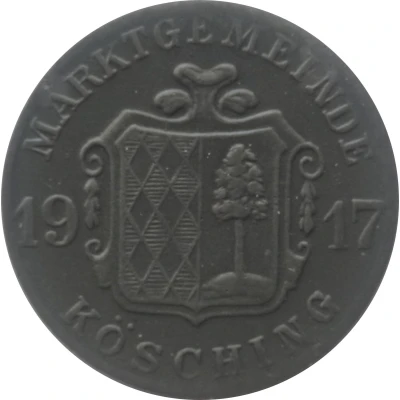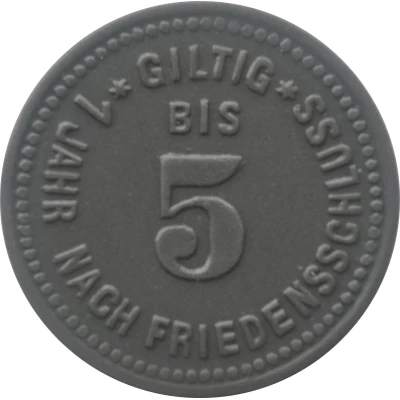


© Willem63 (CC BY-NC-SA)
5 Pfennigs - Kösching
1917 year| Zinc | 1.4 g | 18.0 mm |
| Issuer | Market Town of Kösching (Federal state of Bavaria) |
|---|---|
| Emperor | William II (Wilhelm II) (1888-1918) |
| Type | Standard circulation coin |
| Year | 1917 |
| Value | 5 Pfennigs (5 Pfennige) (0.05) |
| Currency | Mark (1914-1924) |
| Composition | Zinc |
| Weight | 1.4 g |
| Diameter | 18.0 mm |
| Thickness | 0.9 mm |
| Shape | Round |
| Technique | Milled |
| Orientation | Medal alignment ↑↑ |
| Demonetized | Yes |
| Updated | 2024-10-04 |
| Numista | N#343480 |
|---|---|
| Rarity index | 97% |
Reverse
Pearl rim, legend surrounding denomination.
Script: Latin
Lettering:
✶ GILTIG ✶
BIS
5
1 JAHR NACH FRIEDENSSCHLUSS
Edge
Plain
Interesting fact
The 5 Pfennigs - Kösching 1917 coin was minted during a time of economic turmoil in Germany, known as the "Inflationary Period" (1914-1923). During this time, the value of the German mark (the national currency) plummeted, and prices for everyday goods skyrocketed. As a result, many merchants and traders began to use alternative forms of currency, such as this 5 Pfennigs coin, to avoid the inflated prices. This coin, made of zinc and weighing only 1.4 grams, was a more affordable alternative to the traditional silver or gold coins that were previously used. Despite its small value, the 5 Pfennigs - Kösching 1917 coin remains a unique and interesting piece of German history.